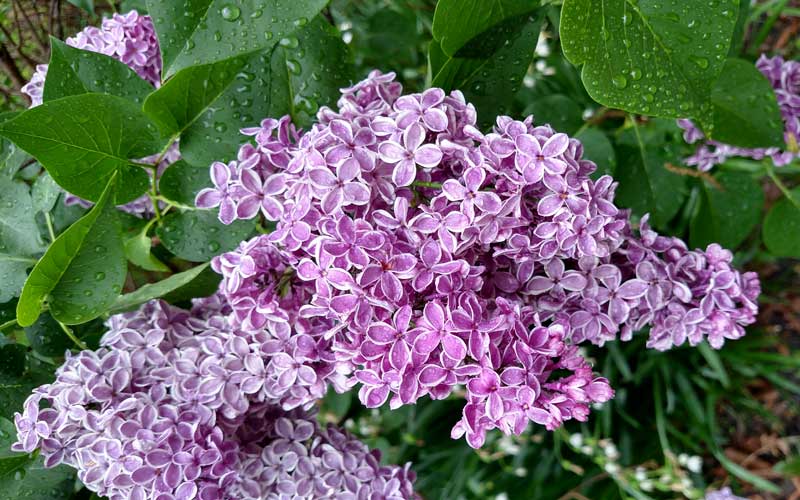3 Classic Flowers You Need in Your Garden

Lilacs
An old-fashioned favorite, lilacs beckon us into the cool spring garden with heady scents and rich colors. Common in New England, where they luxuriate in the cooler summer temperatures, they will perform well here in a spot that keeps them cool(ish) yet sunny. Cool colors of reddish-violet, bluish-purple, creamy-white and pastel pink harmonize well with other woodies and perennials blooming in mid-spring, such as flowering cherries, dianthus (pinks) and phlox subulata (creeping phlox). And for flowers that will continue the blooming season after the lilacs have finished, try ornamental sage (salvia varieties like May Night and Caradonna), summer-blooming “garden” phlox, purple coneflower or daylilies.
Although the “classic” lilacs grow to the size of a small tree, many dwarf forms exist that are excellent for putting the scent right at nose height and for toughing-out our summer heat more gracefully. Undemanding, lilacs do best with an occasional application of lime if your soil tends to stay acidic, and only trim them after the flowers fade.

Clematis
“Queen of the Vines,” they’re called, and for good reason. Delicate in appearance but tough in constitution, this diverse group offers a range of flower styles, colors, and uses in the garden. From 5” wide flowers to dainty 1½” wide bells, from vigorous rambling climbers to compact, reserved clumps, Clematis can be used just about anywhere and can decorate the garden in a number of ways. Climbing up trees, they offer another palette of color with no harm to the tree. You could also use them to cover a trellis, wall (with supports added), pergola, chimney, downspout, mailbox, lamp post, or rambling through other shrubs. Because they use their leaf stems like a tendril, anything slender will do for them to grab a hold of. Or, if they need help, use wiring, twine, or other plant stems to give them support. “Heads in the sun and feet in the shade” is another phrase often used for clematis, which refers to the fact that they flower to their fullest potential in lots of sun but like to have cooler roots, which can be taken care of by shading them with other plants or mulch. If you try them in containers, just remember to give them adequate room to grow and try to keep the soil cool in the summer.
Clematis fall into three groups and can be pruned (or not) three different ways: some flower only in spring, and can be pruned immediately afterwards; some flower only in summer, and can be pruned in winter if needed; the remainder flower in late spring, rest, and bloom again in late summer, and can be pruned at differing times depending on how you want to treat them. Clematis look their best when mixed with other plants – try different clematis varieties or other vines, climbing roses, or an espaliered evergreen.

Roses
There are so many rose varieties that it’s easiest to think of them in terms of type (or class) – Climbing, David Austin, Hybrid Tea, and so on. Different classes of roses have certain things in common – like flowering style and average height – that let you narrow-down which types might work best for you. Many have great fragrances, though sometimes in rose breeding fragrance is sacrificed for better disease resistance. It’s not often that roses can support both perks, but between these traits and flower color, this will also help narrow-down the often-overwhelming array to choose from. You don’t need a formal rose garden to enjoy roses – in fact, using a mix of other plants among your roses will improve their interest and minimize disease or pest problems. We like to think of it this way: “roses are flowering shrubs too,” so don’t forget them as a choice for your cottage-style mixed border, cutting garden, fragrance garden, or for adding colors to your garden palette that other flowering shrubs rarely offer. (Think deep purple, bright orange, multi-colored….) Try them mixed with spirea, butterfly bush, rose-of-sharon, catmint, russian sage, reblooming irises, and geraniums.
by Miri Talabac, Woody Plant Buyer

This Behnke email is a prime illustration of how great it has been to have you as part of my gardening experience. You are so positive, have such helpful discussion topics, and sell such wonderful ‘flora’, including trees, which also bloom.
I am so very sorry you are closing, but understand that sometimes the point comes when change needs to happen. May you find a rewarding replacement for operating the Behnke Nursery, something that really launches you onto the next level of warm, satisfying experiences.
Our McCartney rose bush continues in its 9th year to be ultra prolific. 50 grade A blooms harvested so far with an annual record of 124 from 2017. Very fragrant also, a Behnkes gem
Your blog is lovely and so helpful to read. Thank you for continuing this.